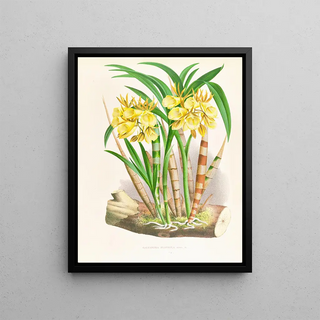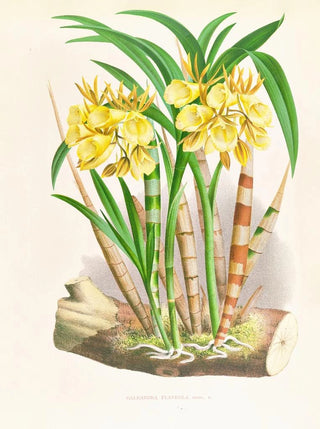Art print | Galeandra flaveola - Jean Jules Linden


View from behind

Frame (optional)
In the vibrant world of floral art, the "Galeandra flaveola" art print by Jean Jules Linden stands out for its delicacy and depth. This piece, a true ode to the fleeting beauty of flowers, invites viewers to immerse themselves in a world where nature expresses itself with striking intensity. The meticulous depiction of this orchid, both rare and precious, reflects the artist's unconditional love for botanical wonders. Gazing at this work, one feels an immediate connection with nature, as if each petal, each shade of color, tells a unique story. Linden manages to capture the very essence of flora, transforming a simple subject into an unforgettable visual and emotional experience.
Style and uniqueness of the art print
Jean Jules Linden's style is characterized by a striking realism, combined with poetic sensitivity that transcends mere botanical drawing. In "Galeandra flaveola," the detail is dazzling, with each stem, leaf, and flower rendered with a precision that borders on photographic. The vibrant colors, ranging from bright yellows to deep greens, create a stunning contrast that draws the eye and captivates the mind. The artist uses light masterfully, playing with shadows and reflections to bring his subject to life. This approach gives the art print an almost three-dimensional quality, inviting viewers to get closer and explore the subtleties of the composition. Far from being a simple botanical illustration, "Galeandra flaveola" is a true celebration of nature, an ode to floral beauty that awakens the senses.
The artist and his influence
Jean Jules Linden, born in 1817 in Brussels, was an artist whose career was intimately linked to botany. Passionate about plants and their representation, he established himself as one of the great masters of 19th-century floral painting. His work is marked by a desire to explore the diversity of plant species while highlighting their aesthetic appeal. Linden collaborated with numerous botanists and naturalists, which allowed him

Matte finish

View from behind

Frame (optional)
In the vibrant world of floral art, the "Galeandra flaveola" art print by Jean Jules Linden stands out for its delicacy and depth. This piece, a true ode to the fleeting beauty of flowers, invites viewers to immerse themselves in a world where nature expresses itself with striking intensity. The meticulous depiction of this orchid, both rare and precious, reflects the artist's unconditional love for botanical wonders. Gazing at this work, one feels an immediate connection with nature, as if each petal, each shade of color, tells a unique story. Linden manages to capture the very essence of flora, transforming a simple subject into an unforgettable visual and emotional experience.
Style and uniqueness of the art print
Jean Jules Linden's style is characterized by a striking realism, combined with poetic sensitivity that transcends mere botanical drawing. In "Galeandra flaveola," the detail is dazzling, with each stem, leaf, and flower rendered with a precision that borders on photographic. The vibrant colors, ranging from bright yellows to deep greens, create a stunning contrast that draws the eye and captivates the mind. The artist uses light masterfully, playing with shadows and reflections to bring his subject to life. This approach gives the art print an almost three-dimensional quality, inviting viewers to get closer and explore the subtleties of the composition. Far from being a simple botanical illustration, "Galeandra flaveola" is a true celebration of nature, an ode to floral beauty that awakens the senses.
The artist and his influence
Jean Jules Linden, born in 1817 in Brussels, was an artist whose career was intimately linked to botany. Passionate about plants and their representation, he established himself as one of the great masters of 19th-century floral painting. His work is marked by a desire to explore the diversity of plant species while highlighting their aesthetic appeal. Linden collaborated with numerous botanists and naturalists, which allowed him






